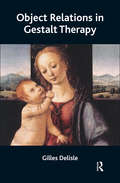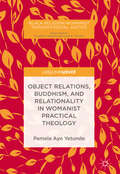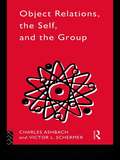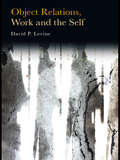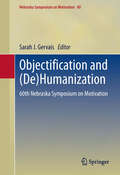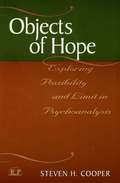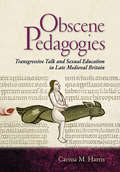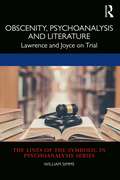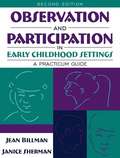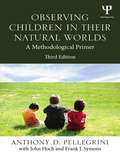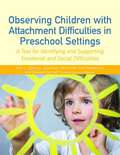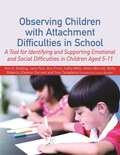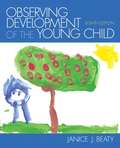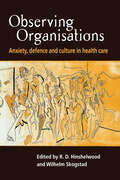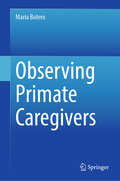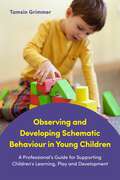- Table View
- List View
Object Relations in Gestalt Therapy
by Gilles DelisleThis book focuses on the psychoanalytic theory of object relations in order to integrate certain pertinent elements of Fairbairn's theory of object relations, to achieve the proposed revision by Perls et al. of Gestalt therapy's theory of the Self.
Object Relations in Psychoanalytic Theory
by Stephen A. Mitchell Jay R. GreenbergExamines the theories of Freud, Sullivan, Fromm, Jacobson, and other psychologists regarding interpersonal relationships.
Object Relations, Buddhism, and Relationality in Womanist Practical Theology (Black Religion/Womanist Thought/Social Justice)
by Pamela Ayo YetundeThis book establishes how Buddhism in the Insight Meditation tradition supports “remarkable relational resilience” for women who are of African descent and same-sex loving, yet living in a society that often invalidates women, African-Americans, LGBTQ people, and non-Christians. Pamela Ayo Yetunde explores the psycho-sexual experiences of African-American Buddhist lesbians, and shows that their abilities to be in healthy relationships are made possible through their Buddhist practices and communities, even in the face of invisibilizing forces related to racial, gender, sexuality, and religious discrimination and oppression.
Object Relations, The Self and the Group (The International Library of Group Psychotherapy and Group Process)
by Victor L. Schermer Charles AshbachThis established text presents a framework for integrating group psychology with psychoanalytic theories of object relations, the ego and the self, through the perspective of general systems theory. It defines and discusses key constructs in each of the fields and illustrates them with practical examples.
Object Relations, Work and the Self
by David P. LevineIn this book, David P. Levine applies psychoanalytic object relations theory to understanding work motivation and the meaning of work. Drawing on the writings of authors such as Donald Winnicott, Otto Kernberg and Melanie Klein, he explores three factors central to our effort to understand work: guilt, greed and the self. Special attention is paid to the factors that determine the individual’s emotional capacity to do work that engages the self and its creative potential and to the related matter of impairment in that capacity. Chapters include: the problem of work greed, envy and the search for the self skill, power and authority work and reality. Object Relations, Work and the Self will be of interest to psychoanalysts and organizational consultants as well as anyone concerned with what determines the quality of life in the workplace.
Objectification and (De)Humanization
by Sarah J. GervaisPeople often see nonhuman agents as human-like. Through the processes of anthropomorphism and humanization, people attribute human characteristics, including personalities, free will, and agency to pets, cars, gods, nature, and the like. Similarly, there are some people who often see human agents as less than human, or more object-like. In this manner, objectification describes the treatment of a human being as a thing, disregarding the person's personality and/or sentience. For example, women, medical patients, racial minorities, and people with disabilities, are often seen as animal-like or less than human through dehumanization and objectification. These two opposing forces may be a considered a continuum with anthropomorphism and humanization on one end and dehumanization and objectification on the other end. Although researchers have identified some of the antecedents and consequences of these processes, a systematic investigation of the motivations that underlie this continuum is lacking. Considerations of this continuum may have considerable implications for such areas as everyday human functioning, interactions with people, animals, and objects, violence, discrimination, relationship development, mental health, or psychopathology. The edited volume will integrate multiple theoretical and empirical approaches on this issue.
Objects of Hope: Exploring Possibility and Limit in Psychoanalysis (Relational Perspectives Book Series)
by Steven H. CooperDespite the importance of the concept of hope in human affairs, psychoanalysts have long had difficulty accepting responsibility for the manner in which their various interpretive orientations and explanations of therapeutic action express their own hopes for their patients. In Objects of Hope: Exploring Possibility and Limit in Psychoanalysis, Steven Cooper remedies this longstanding lacuna in the literature, and, in the process, provides a thorough comparative analysis of contemporary psychoanalytic models with respect to issues of hope and hopefulness. Cooper's task is challenging, given that the most hopeful aspects of human growth frequently entail acceptance of the destructive elements of our inner lives. The analysis of hope, then, implicates what Cooper sees as a central dialectic tension in psychoanalysis: that between psychic possibility and psychic limit. He argues that analysts have historically had difficulty integrating the concept of limit into a treatment modality so dedicated to the creation and augmentation of psychic possibility. And yet, it is only by accepting the realm of limit as a necessary counterpoise to the realm of possibility and clinically embracing the tension between the two realms that analysts can further their understanding of therapeutic process in the interest of better treatment outcomes. Cooper persuasively demonstrates how each psychoanalytic theory provides its own logic of hope; this logic, in turn, translates into a distinctive sense of what the analyst may hope for the patient, and what the patient is encouraged to hope for himself or herself. Objects of Hope brings ranging scholarship and refreshing candor to bear on the knotty issue of what can and cannot be achieved in the course of psychoanalytic therapy. It will be valued not only as an exemplary exercise in comparative psychoanalysis, but also as a thoughtful, original effort to place the vital issue of hope at the center of clinical concern.
Obscene Pedagogies: Transgressive Talk and Sexual Education in Late Medieval Britain
by Carissa M. HarrisAs anyone who has read Chaucer’s Canterbury Tales knows, Middle English literature is rife with sexually explicit language and situations. Less canonical works can be even more brazen in describing illicit acts of sexual activity and sexual violence. Such scenes and language were not, however, included exclusively for titillation. In Obscene Pedagogies, Carissa M. Harris argues instead for obscenity’s usefulness in sexual education. She investigates the relationship between obscenity, gender, and pedagogy in Middle English and Middle Scots literary texts from 1300 to 1580 to show how sexually explicit and defiantly vulgar speech taught readers and listeners about sexual behavior and consent.Through innovative close readings of literary texts including erotic lyrics, single-woman’s songs, debate poems between men and women, Scottish insult poetry battles, and The Canterbury Tales, Harris demonstrates how through its transgressive charge and galvanizing shock value, obscenity taught audiences about gender, sex, pleasure, and power in ways both positive and harmful. She focuses in particular on understudied female-voiced lyrics and gendered debate poems, many of which have their origin in oral culture, and includes teaching-ready editions of fourteen largely unknown anonymous lyrics in women’s voices. Harris’s own voice, proudly witty and sharply polemical, inspires the reader to address these medieval texts with an eye on contemporary issues of gender, violence, and misogyny.
Obscenity, Psychoanalysis and Literature: Lawrence and Joyce on Trial
by William SimmsObscenity, Psychoanalysis and Literature offers a fascinating psychoanalytic reading of four landmark obscenity trials involving the texts of D. H. Lawrence and James Joyce. By tracing the legal histories of Lawrence and Joyce, from censorship to their eventual redemption and transformation into champions of sexual freedom, the book draws a narrative of changing legal, literary and cultural investments. The book examines the four trials of these authors in detail to show how the literary text can function as a symbol of both life and death and the political uses of figuring them as such. Taking a psychoanalytic perspective, we can see how this narrative of sexual repression to sexual liberation may itself be an emergent form of the superego imperative to enjoy and consume. Through close readings of trial transcripts and archival documents, this book helps elucidate the fantasies operating throughout the trials: the unquestioned assumptions of the nature of sexuality, gender, drugs and truth. It demonstrates with clarity how, through its attempt to suppress the sexual, the law confronts its own nature as language and in doing so troubles the distinctions between law, literature and desire that it usually wishes to protect. Offering a uniquely psychoanalytic account of the obscenity trials of these authors, this text will be of great interest to scholars from across the fields of psychoanalysis, law and literature.
Observation And Participation In Early Childhood Settings: A Practicum Guide
by Jean Billman Janice ShermanThis book was written to give readers experience in using effective methods for observing young children's development (ages 0-8) and documenting their observations. The book is designed to guide readers' participation with children of different age groups in a variety of early childhood settings. The book encourages readers to interact with children as they learn more about development by carrying out the activities outlined in each chapter. For anyone involved with the education of young children, or practicing in a related field.
Observing Children in Their Natural Worlds: A Methodological Primer, Third Edition
by Anthony D. Pellegrini Frank Symons John HochThis book shows readers how to conduct observational methods, research tools used to describe and explain behaviors as they unfold in everyday settings. The book now uses both an evolutionary and a cultural perspective. The methods presented are drawn from psychology, education, family studies, sociology, and anthropology, but the author's primary focus is on children in school, family, and social settings. Readers learn how to make observations in real contexts to help them create a verbal picture of behaviors they see. The importance of considering reliability and validity factors while testing within each environment is emphasized throughout. The author draws from the literature that provides methods for observing animals in their natural habitats, but emphasizes the use of observational methods to solve human problems. The book is organized in the way a researcher conducts observational studies—conceptualizing of the idea, designing and implementing the study, and writing the report. “Things to think about” sections provide an opportunity for students to solidify their understanding of the material and the Glossary defines the key terms introduced in the book. Highlights of changes in the new edition include: • The introduction of the cultural perspective in chapter 4 along with the evolutionary (epigenetic theory) perspective and the integration of cultural examples throughout the book. • More varied examples from developmental psychology, family studies, and education.• Extensively revised chapter (3) on ethics reflects the current revelations of scientific fraud and the push for researchers to maximize scientific integrity in their community. • Updated chapter (12) reflects the latest computer technologies used in observational methods including iPhones and Blackberrys for conducting observation, ABC Data Pro and Behavior Tracker for evaluations, and Excel for constructing observational templates. • Expanded chapter (13) on writing the research report and more on issues of plagiarism (ch. 3). • The latest on minimizing observer effects on participants and testing their effectiveness.• New environmentally friendly design, the Things to Think About sections were retained, but the blank pages for answers were eliminated. Intended as a supplementary text for advanced undergraduate and/or graduate courses in research methods and/or developmental research or developmental/child psychology taught in psychology, education, human development, and nursing, educators and researchers concerned with assessing children will also appreciate this book’s introduction to observational methods.
Observing Children with Attachment Difficulties in Preschool Settings: A Tool for Identifying and Supporting Emotional and Social Difficulties
by Ann Frost Sian Templeton Jane Fain Eleanor Durrant Kim GoldingFor preschool children with emotional difficulties arising from difficulties in attachment, standard observations used in early years settings are not always helpful in identifying their problems and providing guidance on how they can be helped. Combining an accessible introduction to attachment and child development with a child observation tool for identifying behaviour, and the emotional needs underlying this behaviour, this book enables early years professionals to identify problems and provide appropriate support. 'Case study' boxes help to illustrate typical patterns of attachment, and all aspects of behaviour are covered including play, interaction with peers, neediness, and aggression. A range of handouts and activities is included, and guidance provided on how to work within professional boundaries. Written in clear, concise language, Observing Children with Attachment Difficulties in Preschool aims to equip the reader with the knowledge and skills needed to identify and support children's emotional and social difficulties. Suitable for use with children aged 2 – 5, this guide will be an invaluable resource for early years professionals, as well as for use by clinicians, teachers and learning support staff.
Observing Children with Attachment Difficulties in School: A Tool for Identifying and Supporting Emotional and Social Difficulties in Children Aged 5-11
by Ann Frost Sian Templeton Netty Roberts Helen Worrall Jane Fain Cathy Mills Eleanor Durrant Kim GoldingEmotional difficulties in children aged 5-11 can display themselves in a range of different behaviours, and it is important for staff in schools to be able to identify and address these problems, and to provide appropriate help. This easy-to-use tool provides an observation checklist which enables staff to identify behavioural patterns in children with social and emotional difficulties, analyse the emotional difficulties underlying these behaviours and establish what kind of help and support the children need. Behavioural responses are categorised within clearly outlined topics, including behaviour, play and relationship with peers, attachment behaviours, emotional state in the classroom and attitude to attendance. Checklists and diagrams identify different 'styles' of relating (secure, avoidant, ambivalent), to help school staff who work with children and their families to respond appropriately to the individual needs of each child. A range of handouts include activities designed to provide emotional support, to focus and regulate behaviour and enable the child to develop important social and emotional skills. Suitable for use with children aged 5-11, this tool will be an invaluable resource for teachers, teaching assistants, learning support staff, school counsellors and educational psychologists.
Observing Development Of The Young Child
by Janice J. BeatyJanice J. Beaty's best-selling Observing Development of the Young Child teaches its audience how to observe, record, and interpret the development of children ages three through five by utilizing a unique checklist to document each aspect of development. This proven resource discusses what these young children are like, and how to support them in their early development with exciting hands-on activities. Even though the new edition has undergone quite an extensive revision, long-time adoptees and fans of the book in its previous editions can rest assured that the author has preserved many of the original features while adapting them to new circumstances of today's early childhood education environment, the key issues, and new research. Streamlined from previous editions, with 12 chapters instead of 14, this practical, easy-to-use system is based on a progression of children's skill development in six major areas: emotional, social, physical, cognitive, language, and creative. Used successfully in early childhood programs all over the country since its inception, this unique and mainstay text looks at child development versus child behaviors, preparing its readers to become avid observers, recording what he/she sees, mastering how to interpret the data, and becoming adept at how to use the observations to plan for the young individuals they will encounter.
Observing Organisations: Anxiety, Defence and Culture in Health Care
by R. D. Hinshelwood Wilhelm SkogstadObserving Organisations presents a unique approach derived from direct participant observation of small units within institutions, all in the health and social services sector. A range of contributors bring together the results of their own observational projects to show how they were able to come to a psychoanalytically informed understanding of the cultures that arise within healthcare organisations, and how this understanding can be used to overcome difficulties that arise.
Observing Primate Caregivers
by Maria BoteroThis book aims to advance our understanding of the caregiver-infant interaction in primates and its effect on the development of social cognition, working from an interdisciplinary approach (i.e., psychology, philosophy, and anthropology), challenging the dominant cognitivist perspectives and methodologies. This book is important because it contributes to understanding how primate parent-and-infant interaction works and how it affects the infant’s development. Understanding this parent-and-infant interaction contributes to finding better ways to support human parents and provide better care for non-human primate mothers and infants in captivity.
Observing and Developing Schematic Behaviour in Young Children: A Professional’s Guide for Supporting Children’s Learning, Play and Development
by Tamsin GrimmerObserving and understanding schematic behaviour confidently is vital for anyone working with or looking after young children. This guide explains what schemas are, stripping back the technical language often used to describe them, and how to interpret and extend schematic behaviour to benefit the child. It looks specifically at 13 different schemas, such as connection, rotation and transportation, and includes case studies, interpretation of the observations and practical ideas for how to use this information to aid children's learning, development and play. Making schemas and schematic behaviour more understandable, this book will give early years practitioners and parents the confidence to identify schemas and plan future learning opportunities to support children based on this knowledge.
Observing and Recording the Behavior of Young Children (Fifth Edition)
by Barbara Lehman Dorothy H. Cohen Virginia Stern Nancy Balaban Nancy GropperThis book gives providers a handbook of information to using appropriate observing and recording techniques as well as how to use this information to make decisions regarding a child's development and educational plan.
Obsessed: A Memoir of My Life with OCD
by Allison BritzA brave teen recounts her debilitating struggle with obsessive-compulsive disorder—and brings readers through every painful step as she finds her way to the other side—in this powerful and inspiring memoir.Until sophomore year of high school, fifteen-year-old Allison Britz lived a comfortable life in an idyllic town. She was a dedicated student with tons of extracurricular activities, friends, and loving parents at home. But after awakening from a vivid nightmare in which she was diagnosed with brain cancer, she was convinced the dream had been a warning. Allison believed that she must do something to stop the cancer in her dream from becoming a reality. It started with avoiding sidewalk cracks and quickly grew to counting steps as loudly as possible. Over the following weeks, her brain listed more dangers and fixes. She had to avoid hair dryers, calculators, cell phones, computers, anything green, bananas, oatmeal, and most of her own clothing. Unable to act “normal,” the once-popular Allison became an outcast. Her parents questioned her behavior, leading to explosive fights. When notebook paper, pencils, and most schoolbooks were declared dangerous to her health, her GPA imploded, along with her plans for the future. Finally, she allowed herself to ask for help and was diagnosed with obsessive-compulsive disorder. This brave memoir tracks Allison’s descent and ultimately hopeful climb out of the depths.
Obsessed: America's Food Addiction--and My Own
by Mika BrzezinskiMika Brzezinski is at war against obesity. 'On Morning Joe,' she is often so adamant about improving America's eating habits that some people have dubbed her "the food Nazi. " What they don't know is that Mika wages a personal fight against unhealthy eating habits every day, and in this book she describes her history of food obsession and distorted body image, and her lifelong struggle to be thin. She believes it's time we all learned to stop blaming ourselves, and each other, and look at the real culprits-the food we eat and our addiction to it. Mika feels the only way to do this is to break through the walls of silence and shame we've built around obesity and food obsessions. She believes we need to talk openly about how our country became overweight, and what we can do to turn the corner and step firmly onto the path of health. So Mika made a deal with her very close friend Diane: they would work together on this book and on their personal goals, to help Diane drop 75 pounds and to break Mika's obsession with staying superthin. As she did in her bestseller 'Knowing Your' 'Value,' Mika has packed each chapter with insights from notable people in medicine, health, business, the arts, and politics. Singer Jennifer Hudson, the late writer and director Nora Ephron, TV host Gayle King, New Jersey governor Chris Christie, and many others open up to Mika about their own challenges and what works for them when it comes to food and diet. It's time we stopped whispering the F-word ("fat") the way we used to shun the C-word ("cancer"). This book-with its trademark Brzezinski smarts, honesty, and courage-launches us into a no-holds-barred conversation with family and friends, in schools and kitchens, in Congress and the food industry, to help us all find ways to tackle one of the biggest problems standing between us and a healthier America.
Obsession: A History
by Lennard J. DavisWe live in an age of obsession. Not only are we hopelessly devoted to our work, strangely addicted to our favorite television shows, and desperately impassioned about our cars, we admire obsession in others: we demand that lovers be infatuated with one another in films, we respond to the passion of single-minded musicians, we cheer on driven athletes. To be obsessive is to be American; to be obsessive is to be modern. But obsession is not only a phenomenon of modern existence: it is a medical category -- both a pathology and a goal. Behind this paradox lies a fascinating history, which Lennard Davis tells in "Obsession". Beginning with the roots of the disease in demonic possession and its secular successors, Davis traces the evolution of obsessive behavior from a social and religious fact of life into a medical and psychiatric problem. From obsessive aspects of professional specialization to obsessive sex and nymphomania, no variety of obsession eludes Davis's graceful analysis. "Obsession" also considers the clinical definition of the condition: Davis investigates the huge increase (estimates suggest up to 600-fold) in diagnosis of obsessive-compulsive disorder over the past thirty years. Surveying the many ways in which doctors today treat OCD, he points out the limitations of and contradictions within the biological definitions of the disease. Impassioned, witty, and learned, "Obsession" is for anyone -- from compulsive hand washers to professional psychologists -- who has been fascinated by, struggled with, or cultivated obsession.
Obsessional Neurosis: Lacanian Perspectives (The\centre For Freudian Analysis And Research Library (cfar) Ser.)
by Astrid GessertDespite the important place it occupies in both Freudian and Lacanian nosology, obsessional neurosis has received far less attention than its erstwhile companion hysteria. This book elaborates and deepen research into questions of obsession, going beyond the usual clichés which reduce obsession to the question "Am I alive or dead?". Emphasis is given to the structure of this neurosis, as distinguished from its symptomatology, and to clinical questions of work with obsessional subjects. The chapters provide discussions of some of the following themes: the creation of the category of obsessional neurosis and of obsessive-compulsive disorder (OCD), the fate of desire and the inability to act in obsession, debt and guilt, obsessional manoeuvres and their implications for the treatment.The book will be of interest to readers with academic or clinical backgrounds who wish to deepen their understanding of obsessional neurosis from a theoretical or clinical point of view. Newcomers to the subject will find signposts here that guide them through the complex landscape of obsession and lead them to avenues they may wish to pursue further.
Obsessions: The Twisted Cruelty
by Francesco BisagniThis book explores the interrelatedness between obsessive compulsive disorders, thinking disorders, and depression. The issue is considered both from a psychiatric viewpoint and from a psychodynamic perspective. The age of the cases presented in the book ranges from childhood through adolescence to adulthood. Obsessions: The Twisted Cruelty is a challenging contribution to contemporary clinical debate, especially regarding the role of analytically-oriented psychotherapy in the treatment of OCD, and how to deal with the psychiatric treatment and combine the two approaches, while keeping the focus on the transference-countertransference interplay. After the first theoretical chapter, the relationship between obsessions and thinking impairments is discussed, with specific reference to delusional ideation. A section entitled "the anal conundrum" follows. Encopresis and anal masturbation during childhood are discussed, as well as the identification of the child with a maternal "faecal object. The last section explores the connection with depression, and some specific features of sadism.
Obsessive Compulsions: The OCD of Everyday Life
by C. Thomas GualtieriAlmost everybody has an obsession or feels a compulsion to do something a certain way. Magic numbers, intrusive thoughts, unusual fears and superstitions happen to about four people out of five, but where do these obsessive-compulsive (OC) traits come from? This book explores what they are, why we have them and what we can do about them, through fascinating and highly original insights. Are you a perfectionist, or can you be fussy? Do you like to have control in certain situations? Or are you overly anxious in others? These are all OC traits, and this book looks at their recent increase in human behaviour, and how they are formed in the brain. Showing that these traits are more common in highly educated, intelligent and successful people, it highlights the positive sides of what have previously been seen as negative quirks. Weaving together sections that are anecdotal and humorous, with technical and up-to-date scientific information, this groundbreaking book gives a fascinating introduction into an under-discussed personality type.
Obsessive Compulsive Disorder
by Joseph ZoharA clear summary of what is known about a highly prevalent and debilitating disorder that affects nearly as many people as does asthma. Expert authors review the biological basis for the disorder and describe both pharmacological and psychological approaches to treatment.
